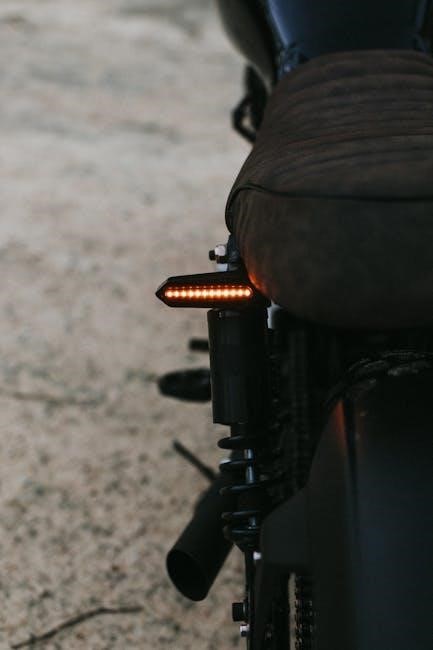Ground Assault Front Bike Suspension: Owner’s Manual Guide
Welcome! This guide provides comprehensive information regarding your Ground Assault front bike suspension. It covers assembly‚ adjustments‚ maintenance‚ and troubleshooting. Understanding this manual ensures optimal performance and safety. Refer to this guide before operating your suspension system‚ enhancing your riding experience.
Identifying Your Ground Assault Bike Model
Correctly identifying your Ground Assault bike model is crucial for finding the appropriate owner’s manual for its front suspension system. The model number is typically located prominently on the bike’s frame‚ often near the bottom bracket or on the head tube. This number unlocks access to specific information tailored to your suspension setup. Understanding your bike model helps ensure compatibility with maintenance procedures‚ replacement parts‚ and adjustment guidelines. A mismatch could lead to improper maintenance‚ potentially damaging your suspension or compromising your safety.
Consulting the correct manual guarantees you have the right information for your specific components. Different models may have varying suspension designs‚ oil types‚ or adjustment mechanisms. Neglecting to identify the correct model could result in using incorrect procedures or parts‚ leading to performance issues or even equipment failure. The owner’s manual provides detailed diagrams and specifications that are unique to your model‚ making it an invaluable resource for maintaining your Ground Assault bike’s front suspension.
Understanding the Importance of Front Suspension

Front suspension on a mountain bike‚ like the Ground Assault system‚ plays a vital role‚ significantly impacting the rider’s overall experience. Its primary function is to absorb shocks from uneven terrain‚ providing a smoother‚ more controlled ride. This absorption reduces fatigue and enhances comfort‚ especially during long rides or challenging trails. A quality suspension system allows the front wheel to maintain better contact with the ground‚ improving traction and control.
This enhanced control is particularly crucial when navigating obstacles or riding downhill. The suspension system helps maintain stability‚ preventing the front wheel from bouncing or losing grip. This translates to increased confidence and safety‚ allowing riders to tackle more challenging terrain with greater ease. Furthermore‚ a well-maintained front suspension protects the bike frame and other components from excessive stress and wear. By absorbing impacts‚ it reduces the strain on the frame‚ extending the lifespan of your bike and preventing costly repairs.
Front Suspension Fork Maintenance
Maintaining your front suspension fork is crucial for optimal performance and longevity. Regular cleaning is essential to remove dirt and grime that can damage seals and internal components. After each ride‚ wipe down the fork stanchions with a clean cloth‚ paying close attention to the seals. Periodically‚ lubricate the stanchions with a suspension-specific lubricant to reduce friction and keep the fork moving smoothly.
Inspect the fork for any signs of damage‚ such as scratches‚ dents‚ or leaks. If you notice any issues‚ address them promptly to prevent further damage. Check the air pressure or coil spring preload regularly‚ adjusting it according to your weight and riding style. Over time‚ the fork oil will degrade‚ affecting its damping performance. Follow the manufacturer’s recommendations for oil changes‚ typically every 50-100 hours of riding. Proper maintenance ensures your fork functions correctly‚ providing a smooth and controlled ride for years to come.
Adjusting Front Suspension: A Step-by-Step Guide
Adjusting your front suspension properly enhances your riding experience. Start by identifying your fork’s adjustment features: air pressure‚ rebound‚ and compression. Consult your owner’s manual for recommended settings based on your weight and riding style. Begin with the air pressure. Use a shock pump to add or release air‚ achieving the recommended PSI for your weight. Next‚ adjust the rebound. This controls how quickly the fork returns after compression. Too fast‚ and the bike feels bouncy; too slow‚ and it packs down on repeated bumps.
Adjust the rebound dial until the fork recovers smoothly without bouncing. Finally‚ adjust the compression. This controls how easily the fork compresses. Increase compression for more support on big hits‚ but decrease it for better small bump compliance. Test your settings on a familiar trail. Make small adjustments until the fork feels balanced and responsive. Remember to consult the manual and experiment to find the perfect setup for your needs.
Types of Suspension Systems
Understanding the various types of suspension systems is crucial for effective maintenance and optimization. Mountain bikes commonly feature coil‚ air‚ or hybrid suspension systems. Coil suspension utilizes a steel spring to absorb impacts‚ providing a linear feel. Air suspension uses compressed air as the spring‚ offering adjustability for different rider weights and riding styles. Hybrid systems combine coil and air‚ aiming to balance the benefits of both.
Each system has unique characteristics. Coil systems are known for their reliability and sensitivity to small bumps. Air systems are lighter and offer greater adjustability. Hybrid systems strive to deliver a plush feel with adjustable progression. Within these categories‚ damper technology varies. Open bath dampers offer consistent performance but can be heavier. Cartridge dampers provide better control and responsiveness. Selecting the right system depends on riding style‚ terrain‚ and budget. Consult your owner’s manual for specific details about your bike’s suspension system.
Essential Tools for Suspension Maintenance
Maintaining your Ground Assault front bike suspension requires specific tools for effective servicing and adjustments. A shock pump with a precise gauge is crucial for adjusting air pressure in air-sprung forks. A set of metric Allen keys and Torx wrenches is essential for disassembling and reassembling various components. A torque wrench ensures bolts are tightened to the manufacturer’s specified torque values‚ preventing damage.
Additionally‚ a seal driver set helps install new seals without damaging them. Pick tools are useful for removing O-rings and seals during rebuilds. Suspension fluid level tools ensure the correct amount of oil is added during servicing. A vise with soft jaws securely holds components without scratching them. Clean rags and a degreaser are necessary for cleaning parts. Having these essential tools ensures you can properly maintain your suspension and extend its lifespan. Always refer to your owner’s manual for specific tool requirements.
Fork Oil and Its Importance
Fork oil is a critical component in your Ground Assault front bike suspension system‚ playing several vital roles. Primarily‚ it provides lubrication for the internal moving parts‚ reducing friction and wear between the stanchions‚ bushings‚ and dampers. This lubrication ensures smooth and consistent suspension performance‚ enhancing rider comfort and control. Fork oil also acts as a damping medium‚ controlling the rate at which the suspension compresses and rebounds. The oil’s viscosity affects the damping characteristics‚ with thicker oil providing more damping and slower movement.

Different weights of fork oil are available to fine-tune the suspension to suit various riding styles and terrain. Regular oil changes are essential because fork oil degrades over time due to heat‚ contamination‚ and mechanical shear. Degraded oil loses its viscosity‚ leading to decreased damping performance and increased wear. Always use the recommended fork oil type and quantity specified in your Ground Assault owner’s manual to maintain optimal suspension function and longevity.
Troubleshooting Common Suspension Issues
Addressing common suspension problems promptly can significantly improve your riding experience. One frequent issue is excessive suspension sag‚ indicating worn springs or insufficient air pressure. Adjusting the preload or replacing the springs can resolve this. Another common problem is a “spongy” or unresponsive suspension‚ often caused by contaminated or degraded fork oil. A fork oil change is usually the solution.
Clicking or knocking sounds during suspension movement may indicate loose components or worn bushings. Inspecting and tightening bolts‚ as well as replacing worn parts‚ can eliminate these noises. If the suspension feels harsh or lacks small bump sensitivity‚ check for proper lubrication and ensure the damping settings are correctly adjusted. Excessive damping can cause a stiff ride‚ while insufficient damping can lead to “wallowing” or instability. Always consult your Ground Assault manual for specific troubleshooting steps and recommended solutions to maintain optimal suspension performance.
Safety Precautions While Maintaining Your Bike

Prioritizing safety during bike maintenance is paramount. Before commencing any work on your Ground Assault front suspension‚ ensure the bike is stable and supported. Utilize a proper bike stand to prevent accidental falls or injuries. Always wear safety glasses to protect your eyes from debris or fluids.
When dealing with suspension components‚ be aware of potential pinch points and sharp edges. Use gloves to protect your hands from cuts and abrasions. If working with fork oil‚ ensure adequate ventilation to avoid inhaling harmful vapors. Dispose of used oil responsibly‚ following local environmental regulations. Never attempt to disassemble or modify suspension components without proper knowledge and tools. Incorrect reassembly can lead to serious malfunctions and potential accidents. If unsure about any procedure‚ consult a qualified bike mechanic. Always double-check your work before riding to ensure all components are securely fastened and functioning correctly. Regular safety checks are crucial for a safe riding experience.

Finding the Right Owners Manual
Locating the correct owner’s manual for your Ground Assault front suspension is essential for proper maintenance and optimal performance. Start by identifying your bike’s specific model. The model number is typically found on the frame‚ often near the bottom bracket or head tube. Once you have the model number‚ visit the Ground Assault website or search online using the model number and “owner’s manual.”
Many manufacturers provide digital manuals in PDF format‚ which are easily accessible and searchable. Ensure the manual you find matches your suspension system’s year of manufacture‚ as specifications may vary between models. If you’re unable to find the manual online‚ contact your local bike shop or the manufacturer’s customer service department. They may be able to provide you with a copy or direct you to the appropriate resources. Having the correct manual ensures you have accurate information for adjusting‚ maintaining‚ and troubleshooting your suspension system‚ leading to a safer and more enjoyable riding experience.
Step-by-Step Guide to Rebuilding RST 191CS Suspension Forks/Shocks
Rebuilding your RST 191CS suspension forks/shocks ensures optimal performance and extends their lifespan. First‚ gather necessary tools‚ including Allen wrenches‚ a socket set‚ a seal driver‚ and fork oil. Begin by removing the front wheel and detaching the brake calipers. Next‚ loosen the top caps of the fork legs while they are still mounted on the bike. Once loosened‚ remove the fork from the bike.
Carefully disassemble the fork legs‚ noting the order of components. Drain the old oil and clean all parts thoroughly with a solvent. Inspect seals and bushings for wear and replace if necessary. Reassemble the fork legs‚ lubricating all parts with fresh fork oil of the correct viscosity. Carefully install new seals using the seal driver. Refill the fork legs with the specified amount of fork oil. Tighten the top caps to the manufacturer’s recommended torque. Finally‚ reinstall the fork on the bike‚ reattach the brake calipers‚ and reinstall the front wheel. Ensure everything is properly secured before riding.